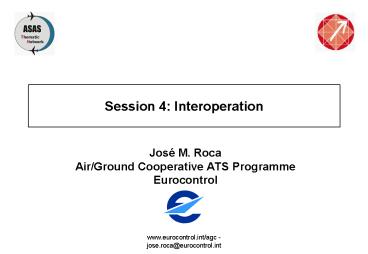Session 4: Interoperation PowerPoint PPT Presentation
1 / 14
Title: Session 4: Interoperation
1
Session 4 Interoperation
- José M. RocaAir/Ground Cooperative ATS
ProgrammeEurocontrol
2
The ASAS Challenge Today
How to accelerate the implementation of ASAS?
3
Presentation Objectives
- Raising some key issues in order to support the
discussions on users expectations and concerns. - Issues to be addressed
- Interoperation, how does it change the
environment, delays, standards, military, ATC
sectors, single sky. - Objectives transition aspects, mixed equipage,
time scales, interoperability between various
types of operation (e.g. military, GA, Airlines)
and between ACCs (e.g. single sky).
4
The Context
- Temporal
- Package 1 2007-2012
- Packages 2/3 from 2012 onwards
- Operational Enviroment
- Oceanic
- Continental
- En-route
- E-TMA, TMA
- Airport
- ASAS Application
- ATSAW
- Spacing
- Separation
- Self-Separation
5
Conceptual Changes for the Future
- Co-operative services to air traffic, managing
the flight trajectory - Strategic organisation of traffic flows and
extended levels of automation - Flight management from gate-to-gate
- Enhanced flexibility and efficiency
- Collaborative decision-making
- Responsive capacity management to meet demand
- Collaborative airspace management
6
Issues Related to the Conceptual Changes
- An essential element of these changes is
- the timely open access to and availability of
consistent, validated and up-to-date information
about - airspace availability conditions (ATM
environment), - flights intentions and their operating conditions
- shared by all of those involved in their planning
and execution (aircraft operators, en-route ATC,
ATFM, airport ATC, and airport operators and
other interested authorities). - ASAS impact
- ASAS is an essential tool to enhance flexibility
and enable efficicency increases. - Can it reduce the quality (i.e. accuracy) of the
flight intentions available for the planning? - Will it reduce or improve the ATM network
predictability?
7
Changes Further Ahead
- Being defined by the ACARE initiative
- Elements of the 2020 targets
- One man cockpit
- Automated Flight
- Automated Air Traffic Control
- ASAS Issues
- Will the future ASAS target only at preventing
collisions? - Or will it also aim towards expediting and
maintaining an orderly flow of traffic?
8
Interoperation with system elements 1
- ASAS and ACAS
- at the level of procedures
- at the level of systems (datalink and CDTI)
- Airspace Users
- Business aviation
- will benefit of the increased flexibility and
efficiency - Military
- Can ASAS improve access to military airspace?
- Datalink Technologies
- Multipe ADS-B links used simultaneouly.
- Multiple CPDLC links used simultaneously (ATN,
FANS-1/A) - Other datalinks (ACARS, Satellite, HF datalink,)
9
Interoperation with system elements 2
- Impact on ATC Tools
- Such as Arrival Manager, Medium Term Conflict
Detection - How will the new ASAS clearances be used by these
tools? - Airspace Structure
- Impact of ASAS on Airspace Design to improve ASAS
efficiency - Will ASAS improveDynamic Sectorisation?
- Will ASAS have an impact on the Multisector
Planner role? - How will ASAS improve the Functional Airspace
Blocks in the European Upper FIR - ASAS navigation requirements
- precision on the ground to improve airport
operations - accuracy and reliability on the air
10
Interoperation with system elements 3
- Airports
- Can ASAS reduce the CFMU time window by
providing more flexibility and capacity? - Improvements to airport mangement and sequencing
using ASAS - How will ASAS contribute to the approaches to
optimise runway use - AOC
- Can ASAS contribute to the fleet management
issues by enabling more sharing of information? - How will ASAS provide AOC with the predictability
they need?
11
Transition
- Between airspace types
- different ASAS procedures in oceanic and
continental - alredy a problem for CPDLC
- Between ASAS levels
- Can ASAS applications of different levels coexist
in the same airspace? - And in contiguous airspaces?
- Would it be confusing for Pilots?
- Mixed equippage
- Mandate
- Segregated Airspace
- TIS-B as a complement?
12
Other Issues
- Environment, how will ASAS
- decrease emissions (reducing holdings)
- reduce noise (via less speed variations)
- reduce the industrial impact
- Security
- How can ASAS be made less vulnerable than todays
ATC? - Should ADS-B be encrypted?
- Should anybody have access to intent data?
13
Questions?
It took one of the greatest minds who ever lived
to design it, but it took 500 years to find a man
with a brain small enough to actually go and fly
it.
14
Summary

